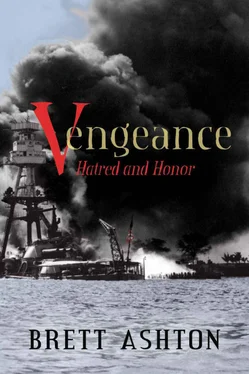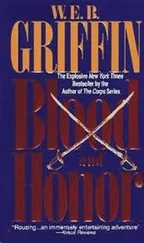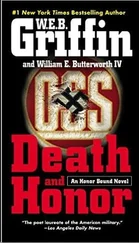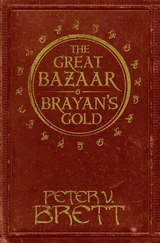After a few days of filling the ship to capacity with ammunition, supplies, and fuel, we pulled out and set course, along with the rest of the ships in our task force, for the Philippine islands. The Japanese were about to be run over by an angry Buffalo .
Along the way, I got permission from the admiral to do a kind of mini-shakedown on the Buffalo . How fast would she go from full speed to full stop or from full stop to full speed? How quickly would she turn at different speeds? How far would she roll in sharp turns at different speeds? And for the crew: how quickly could we get to battle stations, and how would they perform when they got there? I would give the orders when the crew least expected it. I needed to see what she and the crew could do.
When people talk of the Battle of Leyte Gulf, they often bring up the special significance of the battleships that were at Pearl Harbor. History often mentions five of the six battleships that participated in the action at Surigao Straight were either damaged or sunk at Pearl, and now those ships had a chance to pay the Japs back in spades. The same meaning applied to me, the commanding officer of the light cruiser Buffalo . And pay them back we did.
We knew they were coming. We knew there would be a big fight there. We didn’t know exactly when, but a large force of the Japs had to come through Surigao Straight if they wanted to disrupt the landings at Leyte Gulf. We had time to set up, so nothing could possibly get through and live to tell about it.
On one end of the narrow straight was the moderate force of Japanese battleships, cruisers, and destroyers, pretty much in single file. On the other end was the almost-perfect death trap set by the Seventh Fleet waiting for them: six battleships, nine cruisers, twenty-eight destroyers and several torpedo-equipped PT boat squadrons.
It should have been, and in a lot of ways was, a classic battle-line surface-to-surface engagement, at least as far as the actual naval battle was concerned. But the Japanese had a new trick up their sleeve.
The battle happened on the night of the twenty-fifth of October of ’44. We were part of a large formation of ships in the battle line just aft of the Shropshire and on the side of the battleships closest to the Japanese.
Messages of contacts with the enemy had begun coming in from the patrol boat squadrons earlier in the evening and increased as the night wore on. The PT boats and destroyers continued to do their jobs, harassing the enemy until the enemy got within firing range of the American cruisers and battleships. Then all hell broke loose.
We picked a target in the Japanese formation, using our radar, and I gave the order to commence firing after the obligatory check to make sure my forty-five was ready. At about the same time, the battleships began to fire as well. Flashes of fire lit up the horizon all around us as large shells from the battle wagons whistled in the air directly above our heads and landed on the enemy formation.
They could only fire half as much back at us because they were on the approach and could only use their forward guns, whereas we were almost stationary and could deliver full broadsides from all of our guns.
And it was, for me, an awesome sight to see, remembering a morning several years earlier being in the water of Pearl Harbor, watching five of these very same battleships sinking or in flames around me. And I knew a lot of Japs were dying. I could just feel in my mind their horror as their lives slipped away into the darkness of the night in the waters of Surigao Straight.
It was great, as far as I was concerned, and I reveled in it.
After the attack, the fleet that ambushed the Japanese at Surigao Straight began to break up into smaller units. We still had to be sure the marines of the invasion force were covered, as well as be sure the Japanese didn’t have some other unknown force for us to deal with, but a lot of the smaller ships were sweeping for mines, submarines, and aircraft and picking up survivors of the ships that got sunk.
When you are picking up survivors from an enemy ship, you are basically on an intelligence-gathering mission. Sometimes, you might even get a Japanese captain or admiral; you never know.
The man put in charge of our particular task force, which consisted of two cruisers and three screening destroyers, was Rear Admiral Kriston, who put his flag on the Buffalo .
One of the things nobody expected was what happened the day after the battle when we started picking up the survivors from the ships we sunk.
“Sir,” the major said, “we’ve gotten several out of the water but most are refusing rescue and trying to swim away.”
Just then, there was a small explosion near where the rescue operation was happening. I turned to the bridge phone talker and said, “Report!”
“Repeat your last?” he said into the phone then listened to the answer.
After a few seconds, he turned to me and told me, “Sir, it seems one of the Nips they just pulled out of the water was rigged with a grenade and blew himself up.” There were five men down, not counting the one that just blew himself up. Medics were already on the scene to patch up the injured Japs that were being pulled out of the water, so help for the injured marines was right there.
It seemed like a waste of perfectly good medical supplies to take care of injured Japanese, but orders are orders.
“How badly are they hurt?” I asked, noticing the major’s concerned expression.
“Two marines dead, three injured and being taken to medical,” was the report.
“Fine,” I said to the major. “If they don’t want to experience the excellent hospitality of the Buffalo , then screw them. Shoot them in the water and let the sharks clean up the mess. It’s better than having them fight us again later or kill more of us trying to save them.”
“Shoot them in the water, sir?” he asked.
“You heard me, major. Those are your men that just got killed trying to rescue those slant-eyed bastards. If they are enemy combatants refusing to surrender, we are going to treat them as such and shoot them.”
I walked out onto the open bridge on the port side, pulling out my forty-five, recalling how the Japs had strafed me while I was swimming away from the Oklahoma during the Pearl Harbor attack and started to shoot at some of the Japs in the water. I’m sure I had hit at least one of the closer ones (mostly because of the screaming) before the first magazine went empty. I reloaded and put my gun in its holster and turned to the major. “Tell any of the Nips we come to, if they want to be rescued, they are to strip off all of their clothes. From here on out, if they try to swim away or if they approach this ship with anything big or small, shoot them without a second chance. If they want to try to smuggle another grenade on board, they’ll have to hide it by putting it up their ass.”
The major smiled a little bit and said, “Yes, sir!” as he turned around to walk away.
Another thing that worried me was the slowness of the rescue. The longer we took to pick these sons of bitches up, the less we were moving, and the more of a target we became for more air attacks or, even worse, submarine attacks. I kind of suspected, rightly or wrongly, the Japs in the water knew that and were swimming away from us as a stalling tactic to keep us here and moving slow while a submarine maneuvered into position for the kill.
“CIC,” I said to the talker, “I want to know everything that shows on the radar the second you see it. Tell all lookouts to be sharp. Radio, I want all action reports on enemy submarines from the fleet sent to me via Lieutenant Disalle in CIC immediately. Also, send a report of this incident to Admiral Oldendorf and Rear Admiral Kriston. Priority urgent.” The talker went about his business as I went out to watch the sky and the water myself.
Читать дальше












